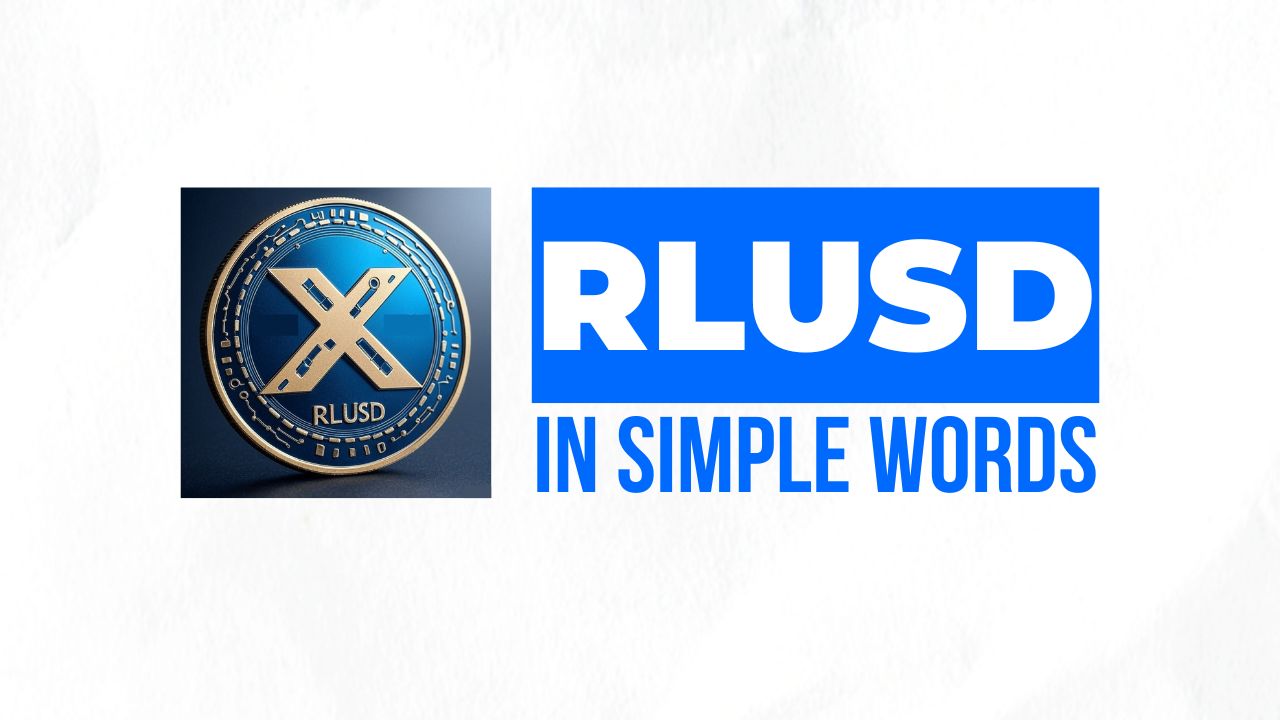What is RLUSD?
RLUSD is a stablecoin launched on December 17, 2024. The coin is regulated under the strict rules of the New York Department of Financial Services (NYDFS), making it one of the more trusted options in the market.
RLUSD is slowly gaining popularity and already has a market cap of $388 million.
While big names like USDT and USDC still lead the stablecoin market, Ripple is trying to stand out by focusing on businesses. It’s doing this through RippleNet, strong regulation, and the ability to work across different blockchains like the XRP Ledger (XRPL) and Ethereum.
Since RLUSD is backed by the US dollar, it’s seen as a stable and safe option for users who want to move between traditional finance and decentralized finance (DeFi).
Also Read – USDC vs. RLUSD vs. USDT – Key Differences and Why They Matter
Here are five important facts you should know about RLUSD:
1. Issued by Ripple Labs’ Subsidiary
Fact: RLUSD is issued by Standard Custody & Trust Company, LLC, a Ripple Labs, Inc. subsidiary regulated by the New York Department of Financial Services (NYDFS).
Significance: This centralized issuance places control over RLUSD’s operations, reserves, and compliance squarely with Ripple Labs. While the NYDFS trust charter ensures regulatory oversight, it contrasts with the decentralized ethos of many crypto projects, raising questions about transparency and single points of failure.
Latest Developments: As of June 2025, Ripple’s advisory board includes high-profile figures such as former FDIC Chair Sheila Bair and former IMF Chief Economist Raghuram Rajan, which enhances RLUSD’s institutional credibility. However, the XRPL’s “clawback” amendment, implemented in January 2025, allows Ripple to freeze or retrieve RLUSD tokens under legal orders. This feature has amplified concerns around centralization, especially among DeFi purists.
2. Fully Backed by USD and Treasuries with Monthly Attestations
Fact: RLUSD is a fiat-collateralized stablecoin, backed 1:1 by USD cash deposits, short-term US Treasury securities, and cash equivalents held by a licensed custodian. Ripple publishes monthly third-party attestation reports by BPM, a reputable accounting firm, to verify reserves.
Transparency: While Ripple’s commitment to NYDFS oversight and monthly audits sets a high standard, RLUSD lacks real-time, on-chain proof of reserves—a feature some competitors like Circle’s USDC are exploring. Ripple is also pursuing global regulatory licenses to enhance user trust.
Significance: The USD and Treasury backing ensures stability, making RLUSD particularly appealing to risk-averse institutions. However, the absence of live reserve verification may deter users who prioritize maximum transparency.
Latest Developments: As of May 2025, RLUSD’s market cap reached $245 million, with 55% ($135 million) on Ethereum and 45% ($110 million) on XRPL. BPM’s attestations confirm full backing, with the latest report in April 2025 showing $240 million in reserves. Ripple also secured a license from the Dubai Financial Services Authority (DFSA) in March 2025, expanding its regulated footprint in the UAE.
3. Native to XRPL with Multi-Chain Expansion
Fact: RLUSD is native to the XRP Ledger but also operates as an ERC-20 token on Ethereum through bridging technology. Ripple plans to expand RLUSD to additional blockchains, with Solana and Hedera under consideration. As of June 2025, only XRPL and Ethereum are active.
Primary Use Cases:
- RippleNet’s On-Demand Liquidity (ODL): RLUSD provides a stable USD-denominated asset for cross-border payments, reducing reliance on XRP’s volatility in RippleNet corridors (e.g., US-Mexico).
- XRPL DeFi: Powers lending, borrowing, and liquidity pools on XRPL’s decentralized exchange (DEX).
- Multi-Chain DeFi: Supports Ethereum-based DeFi protocols, with $180 million in collateral as of May 2025.
- Trading & Hedging: Offers a stable asset for crypto traders, with pairs like RLUSD/XRP and RLUSD/MXN available on exchanges.
Significance: RLUSD’s value lies in its integration with Ripple’s enterprise payment network and its potential to bridge traditional finance with DeFi. While the stablecoin’s multi-chain ambitions aim to broaden its reach, success will ultimately depend on adoption beyond Ripple’s core ecosystem.
Latest Developments: RLUSD is listed on 12 exchanges, including Uphold, Bitso, Bitstamp, MoonPay, Archax, CoinMENA, Bullish, Mercado Bitcoin, Independent Reserve, Sologenic, Kraken, and OKX. XRPL’s liquidity pool total value locked (TVL) hit $85 million in May 2025, up from $50 million in February. Ethereum DeFi collateral rose to $180 million, thanks to integrations with protocols like Aave. Ripple’s partnership with Axelar for XRPL-EVM sidechain bridging also enhances interoperability.
4. Strengths: Enterprise Focus and Regulatory Edge
Pros:
- RippleNet Integration: RLUSD streamlines cross-border payments for Ripple’s 300+ financial institution clients. For instance, Santander Bank’s use of RLUSD reduced remittance costs by 70% and processing times from three days to just 20 seconds.
- Regulatory Compliance: With NYDFS and DFSA licenses, plus monthly attestations, RLUSD stands out as a trusted option amid regulatory scrutiny of stablecoin competitors like USDT. Ripple continues to pursue proactive licensing in jurisdictions such as Singapore.
- XRPL Liquidity Boost: RLUSD transactions consume XRP for gas fees, boosting demand for XRP. XRPL’s ability to handle 1,500 transactions per second (TPS) at a cost of $0.0002 enhances network efficiency.
- Brand Credibility: Ripple’s decade-long experience in enterprise blockchain, with partners like Bitstamp and MoonPay, gives RLUSD a strong foundation.
Significance: RLUSD’s enterprise-centric model and strong regulatory backing make it a compelling option for institutions cautious about less-regulated stablecoins. Additionally, its role in boosting XRPL activity could benefit the broader XRP ecosystem.
Latest Developments: RLUSD’s market cap grew 45%, rising from $169.5 million in March to $245 million in May 2025—an indicator of growing enterprise adoption. Partnerships with major market makers like B2C2 and Keyrock help ensure liquidity on exchanges. Ripple’s Q1 2025 report noted a 30% increase in RippleNet ODL transactions using RLUSD, particularly across Asia-Pacific corridors.
5. Challenges: Centralization and Market Dominance
Cons & Debates:
- Centralization Concerns: Ripple Labs’ control over RLUSD’s issuance, reserves, and clawback feature continues to alienate DeFi users who prioritize decentralization. The risk of a single point of failure also remains a concern.
- Adoption Hurdles: RLUSD’s $245 million market cap is small compared to USDT’s $145 billion and USDC’s $36 billion. Convincing users to switch may require offering a stronger value proposition beyond RippleNet.
- Regulatory Uncertainty: Despite approvals from NYDFS and DFSA, RLUSD faces challenges in the EU due to delays in MiCA compliance. The SEC’s May 2024 claim that RLUSD is an unregistered asset, though disputed by Ripple, adds further scrutiny.
- Dependence on Ripple: RLUSD’s success is closely tied to Ripple Labs’ financial health and regulatory standing. The SEC’s $125 million fine in 2023, though resolved, underscores the risks involved.
Significance: RLUSD must overcome both entrenched competition and concerns about centralization to achieve wider traction. Regulatory challenges, particularly in the EU, could limit its ability to expand globally.
Latest Developments: RLUSD is still unavailable in the EU, though Ripple is targeting MiCA compliance by Q4 2025. Despite ongoing SEC scrutiny, NYDFS oversight provides a regulatory buffer in the U.S. XRPL DeFi’s growth remains modest, with a TVL of $85 million compared to Ethereum’s $100 billion. Ripple’s $10 billion valuation in Q2 2025 supports RLUSD’s backing but also underscores its dependence on the parent company.
Also Read – I Created the Best Bitcoin Guide You’ll Ever Read
The Bottom Line
RLUSD is Ripple Labs’ bold attempt to disrupt the stablecoin market, leveraging RippleNet’s enterprise network and a compliance-first approach. Its USD/Treasury-backed model, NYDFS and DFSA licenses, and $245 million market cap as of May 2025 highlight early success. Integration with RippleNet and XRPL, along with increasing traction in Ethereum-based DeFi, positions RLUSD as a versatile and promising digital asset.
However, major hurdles remain. Centralization concerns, the dominance of USDT and USDC, and regulatory uncertainties—especially in the EU and the U.S.—continue to pose significant challenges.
This article is for informational purposes only and should not be considered financial advice. Investing in stocks, cryptocurrencies, or other assets involves risks, including the potential loss of principal. Always conduct your own research or consult a qualified financial advisor before making investment decisions. The author and publisher are not responsible for any financial losses incurred from actions based on this article. While efforts have been made to ensure accuracy, economic data and market conditions can change rapidly. The author and publisher do not guarantee the completeness or accuracy of the information and are not liable for any errors or omissions. Always verify data with primary sources before making decisions.

